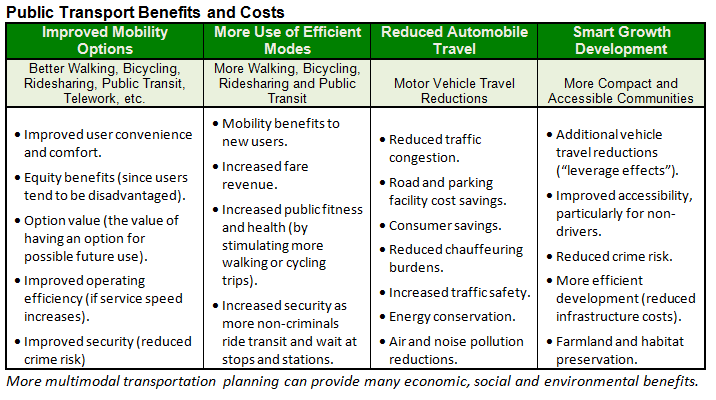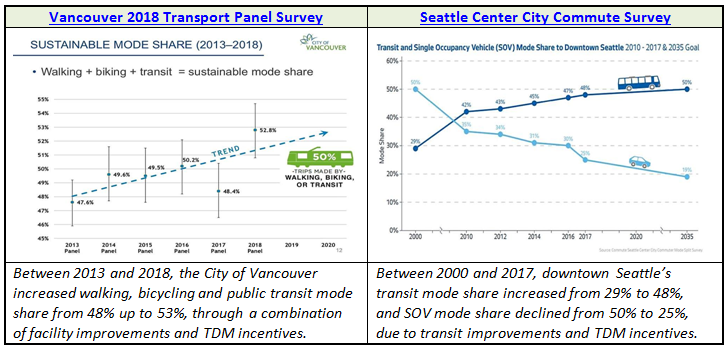How people travel varies significantly between communities. Although many cities are automobile dependent, with most residents owning a personal automobile which they use for most trips, some cities have much more multimodal transportation systems, were residents own fewer cars, drive less and rely more on walking, bicycling and public transit. An efficient, multimodal transportation system provides many economic, social and environmental benefits, including direct benefits to motorists who experience less traffic and parking congestion, reduced risk from other drivers, and reduced chauffeuring burdens.

Current demographic and economic trends are increasing demand for multimodal transport. Although few people want to forego driving altogether, consumer preference surveys indicate that many would prefer to drive less and rely more on walking, bicycling and public transit, provided those options are convenient, comfortable and affordable. Similarly, many communities want to reduce infrastructure costs and pollution emissions, and create more affordable and inclusive communities. Multimodal planning can help achieve those goals.
Experience in nearby communities, including Vancouver and Seattle, demonstrate that large vehicle travel reductions can be achieved by shifting money and road space currently dedicated to automobile travel to more resource efficient modes, as illustrated below.
We can too! Multimodal planning can allow travelers to choose the best mode for each trip: walking and bicycling for local errands, public transit when travelling on busy urban corridors, and automobiles when they are truly most efficient overall, considering all benefits and costs. The following are specific strategies for improving and encouraging resource-efficient travel modes in the South Vancouver Island region.
Accelerate implementation of the Transit Future Plan. This strategic plan can significantly improving public transit service, including rapid (grade-separated) and frequent transit service on major corridors, more local services, and better integration. The only problem with this plan is that it is scheduled to take 25 years, so most current residents will be retired or dead before it is fully operational. With increased funding (the funding that would otherwise be used for fare-free transit) we could implement this plan in a decade, similar to Los Angele’s Measure M, a referendum approved by 67% of voters which will fund implementation of the region’s 30-year transit plan in just ten years.
Improved interregional transit connections. Currently, transit connections between Victoria and Vancouver are often inconvenient and uncomfortable, and between Victoria and Cowichan Valley or Nanaimo almost non-existent. Transit-ferry connections could be improved with better user information, integrated fares, transit ticket sales in ferry gift shops, bus shelters at ferry terminals, all-door bus loading with prepaid fares, and more frequent bus service to ferry terminals. Frequent and affordable bus service over the Malahat would reduce driver stress, traffic congestion, accidents and consumer costs, and improve mobility options for non-drivers, both on the Malahat Highway and downstream, as described in Rethinking Malahat Solutions: Or, Why Spend A Billion Dollars If A Five-Million Dollar Solution Is Better Overall?
Transportation Demand Management (TDM) incentives. TDM includes many strategies that encourage travellers to use the most efficient option for each trip, including commute trip reduction programs, campus transport management, parking policy reforms, pedestrian and bicycling improvements, rideshare matching, carshare services, improved user information, and mobility management marketing. These reward travellers for using the most efficient option for each trip; for example, parking cash out gives commuters who walk, bicycle or use public transit financial rewards comparable to parking subsidies provided to motorists. Many employers and campuses have TDM programs, but we can do much more. California and Washington states, and cities such as Kelowna, Portland, San Francisco, and Seattle mandate and support TDM programs. So could we!
Transit Oriented Development (TOD) policies. TOD (also called Smart Growth and location-efficient housing) refers to development policies that create compact, mixed, walkable neighborhoods around transit stations, to maximize the number of jobs and homes located where residents can minimize automobile travel and rely more on walking, bicycling and public transit. Consumer preference surveys indicate that many households want to live in such neighborhoods, and everybody benefits if they can (residents of such areas generate far less traffic and parking congestion, accident risk and pollution emissions), yet many current policies discourage compact infill, increasing sprawl and automobile travel.
—
Cities for Everyone supports more affordable housing and transportation, in order to provide security, mobility and opportunity for people with all incomes and abilities
www.citiesforeveryone.org
